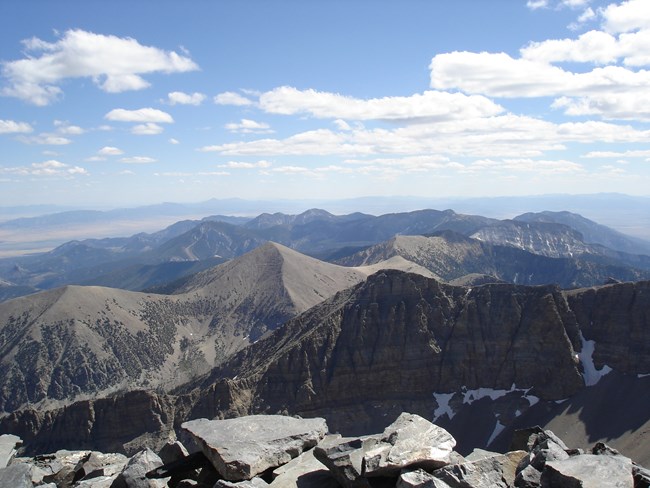
NPS Photo
Great Basin National Park was established in 1986. At that time, the lands previously designated as Lehman Caves National Monument were incorporated into the park. The park lies entirely within the Great Basin Desert, which is considered a high-elevation desert environment. Due in part to its distance from urban centers, the park contains many relatively pristine water resources and has some of the best visibility and dark night skies in the nation. It contains distinctive natural resources such as a rock glacier, six subalpine lakes, and the longest cave in Nevada (Lehman Caves).
The Mojave Desert Network provides natural resource inventory and monitoring information to help parks make effective, science-based management decisions. Inventories have been completed for mammals, fish, birds, vascular plants, and reptiles & amphibians (see species lists further down the page). Maps and reports detailing Great Basin's vegetation, soils, and geology resources are also complete.
The Mojave Desert Network carries out regular monitoring at six subalpine lakes and nine streams within the park. At the lakes, data on water quality, chemistry, and lake level are collected every year. At the streams, water quality and discharge data are collected continuously throughout the summer, and the streams are visited once per year for additional water chemistry and benthic macroinvertebrate sampling. Water monitoring is carried out jointly by our network and Great Basin staff.
Monitoring at Great Basin National Park
Ongoing Monitoring Efforts
Aspen monitoring aspen stands
Bats monitoring bat populations using acoustic and capture surveys
Integrated Uplands vegetation and soils monitoring of the Sagebrush community
Invasive & Exotic Plants monitoring plan for detecting invasive plants throughout the park
Selected Large Springs monitoring water quality and availability at three larger persistent springs
Streams & Lakes monitoring water quality, water chemistry, and availability at six subalpine lakes and nine streams
Weather and Climate monitoring temperature, precipitation, wind and other variables at park service and partner weather stations
White Pine monitoring Great Basin bristlecone pines, limber pines, and their associated pests
Reports & Publications
Inventories & Assessments present baseline data collected during the first phase of the development of the Mojave Desert Inventory & Monitoring Network in order to have comparison with the long-term monitoring data currently being collected. Monitoring protocols describe why and how we collect, manage, analyze, and report monitoring data about the network's Vital Signs. The protocols consist of a narrative and associated set of standard operating procedures (SOPs). Monitoring Reports summarize data and findings from our Vital Signs monitoring activities.
Source: NPS DataStore Collection 4376 (results presented are a subset). To search for additional information, visit the NPS DataStore.
Source: NPS DataStore Collection 4378 (results presented are a subset). To search for additional information, visit the NPS DataStore.
Source: NPS DataStore Collection 4380 (results presented are a subset). To search for additional information, visit the NPS DataStore.
Source: NPS DataStore Collection 4379 (results presented are a subset). To search for additional information, visit the NPS DataStore.
Select a Park:
Select a Species Category (optional):
Visit NPSpecies for more comprehensive information and advanced search capability. Have a suggestion or comment on this list? Let us know.
Last updated: May 31, 2023
